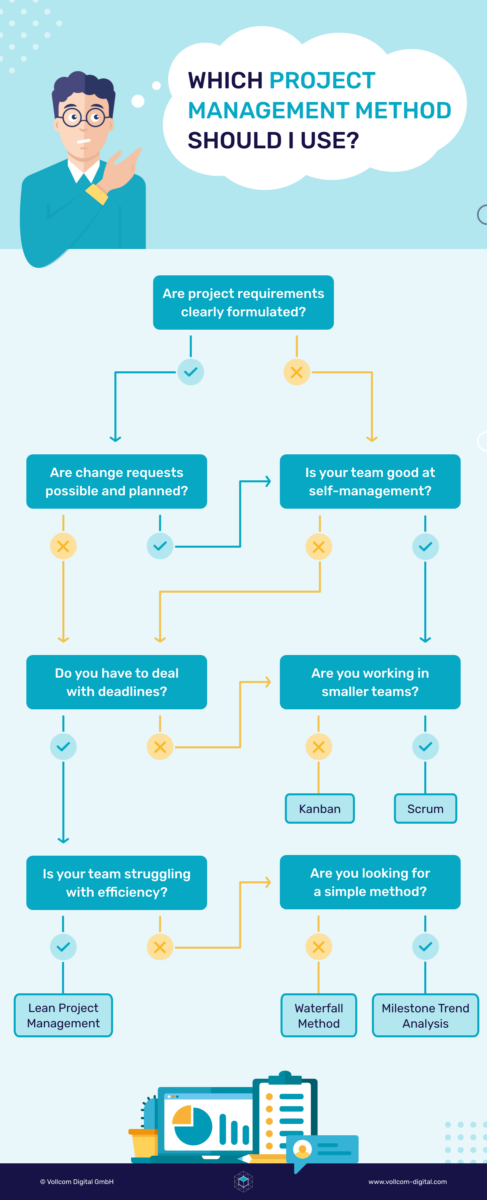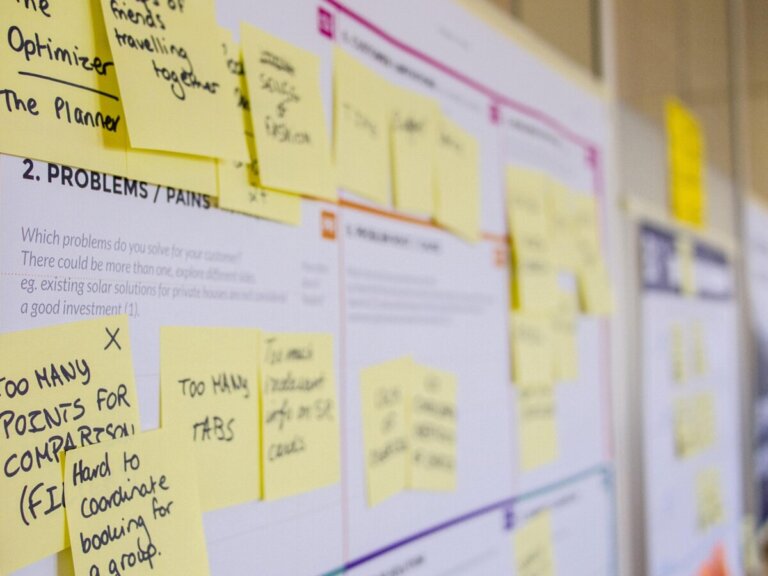Author: Carina Czisch
· 3 mins read · 2,243 views
6 Project Management Methods in Comparison
Project management is about successfully completing a project within a specified time. Not only human and financial resources have to be used in the best possible way for this. It also needs good organization in terms of workflow. Various project management methods help with this. As a project manager, you should know some of them well in order to use them for different teams.
What are Project Management Methods?
A project management method describes an approach to a project. It can also be understood as a principle, technique or procedure. Each method ultimately delivers different results. But the work processes or the composition of the team can also be very different depending on the method used.
What Project Management Methods are There?
1. Waterfall Model
The waterfall model describes a classic process in project management. Behind this is a linear workflow in which the steps are processed one after the other. A new work step is only started when the previous one is completed. Another important feature here is that the project manager must plan all resources thoroughly at the beginning. Changes or adjustments that appear during the project can only be implemented with difficulty or not at all. This method is therefore suitable for clearly structured workflows that are dependent on one another.
2. Milestone Trend Analysis
The milestone trend analysis is a simple model for keeping an eye on the timeline of a project. At the beginning, clearly defined milestones and a time frame for the project are determined. Compliance with the defined milestones is checked in fixed cycles and displayed graphically. Regular meetings are important in order to uncover possible obstacles. This method is particularly suitable for less extensive projects with predictable processes.
3. Lean Project Management
Lean means “lean”. Because this is about not wasting resources. The optimal balance of resources optimizes processes and maximizes efficiency and teamwork. In the end, of course, the customer also benefits. A distinction is made here between 3 types of resource wastage:
- Muda (waste): Processes that do not add value
- Mura (Imbalance): Losses from unbalanced processes
- Muri (Overload): Unbalanced load on resources
This method is particularly suitable if costs and resources are to be saved in the long term and customer proximity plays a major role.
4. Agile Project Management
Agile does not describe a method, but rather an approach. This is probably the most used. It is based on the 12 principles of the agile manifesto. Implementation methods that are aligned with this are, for example, Scrum or Kanban (which are described below). This method is suitable for complex projects whose requirements are only vaguely known and therefore involve many risks.
5. Scrum
Working with Scrum is based on the Agile Manifesto. Here, project steps are broken down into smaller, repeating sprints. There are clear rules, roles and processes. Scrum follows an iterative, incremental approach and is therefore very different from the classic waterfall method. Here, a complete product is not presented at the end, but intermediate results that are already working are delivered. This method is particularly suitable for smaller teams that need complete flexibility.
6. Kanban
There is no predetermined procedure for this method. As with Scrum, the teams work very independently. The focus is on good teamwork, prioritized tasks and regular feedback loops. The workflow can be visualized using Kanban boards. Usually you work with only 3 columns: “To-Do”, “Doing” and “Done”. The simple division helps not to lose the overview. This method is suitable for almost all projects and teams.
Infographic: Which Method is Right for My Team?
Our infographic is intended to give you an approximate direction as to which project management method best suits your way of working.

Final Thoughts
Which project management method is ultimately the right one for a project cannot be answered in general terms. Rather, this decision depends on many components such as the complexity of the project or the size of the team. It is therefore necessary to look individually at which approach best meets the project requirements.
Looking for Expert IT Solutions?
Subscribe to Our Newsletter for Exclusive Tips and Updates!
Stay ahead of tech challenges with expert insights delivered straight to your inbox. From solving network issues to enhancing cybersecurity and streamlining software integration, our newsletter offers practical advice and the latest IT trends. Sign up today and let us help you make technology work seamlessly for your business!



Share